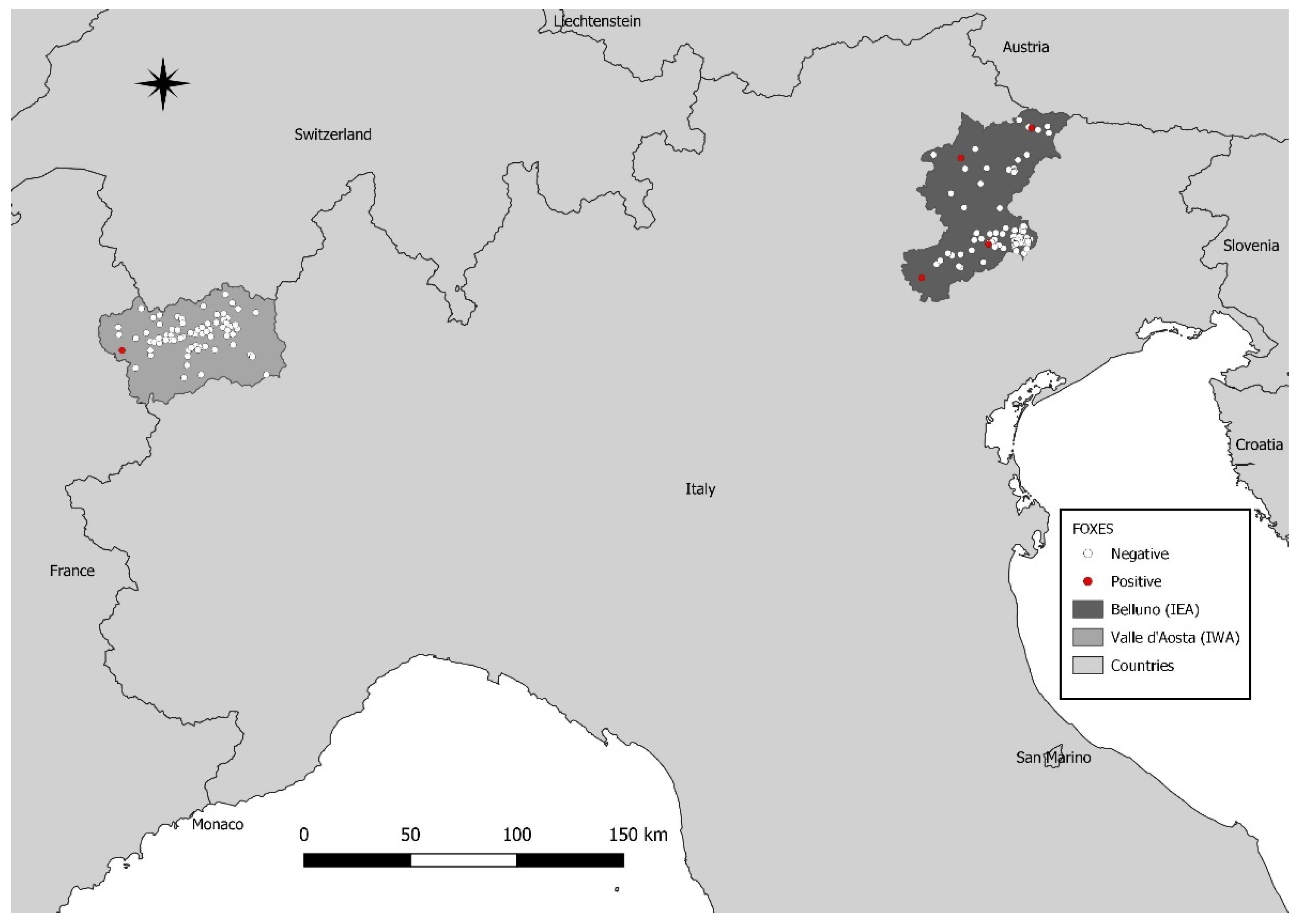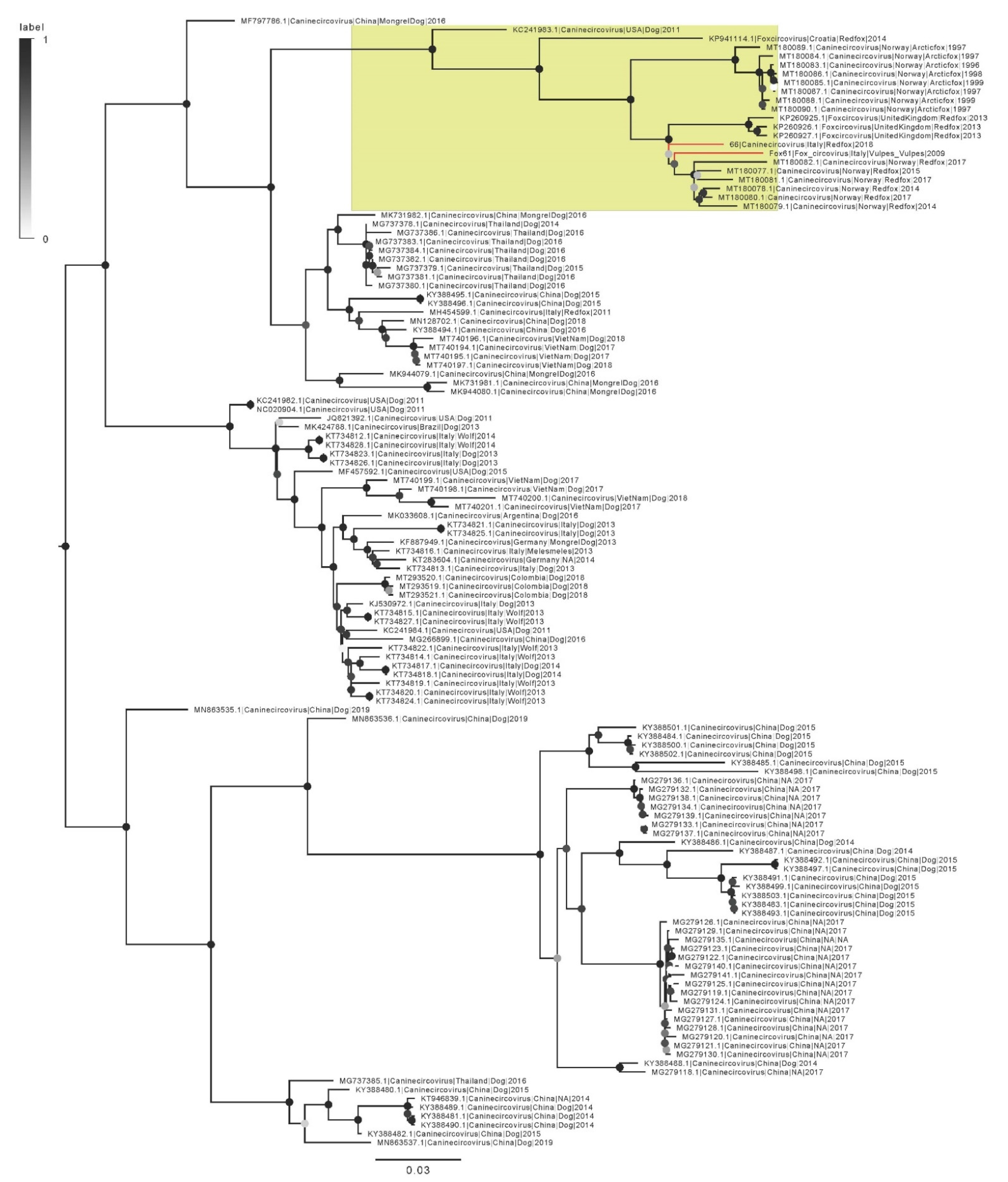Canine Circovirus in Foxes from Northern Italy: Where Did It All Begin?
Abstract
:1. Introduction
2. Results
2.1. CanineCV Diagnosis and Genetic Characterization
2.2. Phylogenetic Analysis
2.3. Phylodynamic Analysis
3. Discussion
4. Materials and Methods
4.1. Samples
4.2. CanineCV Diagnosis and Sequencing
4.3. Phylogenetic Analysis
4.4. Phylodynamic Analysis
Supplementary Materials
Author Contributions
Funding
Institutional Review Board Statement
Informed Consent Statement
Data Availability Statement
Conflicts of Interest
References
- Franzo, G.; Segalés, J. Circoviruses (Circoviridae). In Encyclopedia of Virology; Bamford, D.H., Zuckerman, M., Eds.; Elsevier Science: Amsterdam, The Netherlands, 2020; pp. 182–192. ISBN 9780128145166. [Google Scholar]
- Duffy, S.; Shackelton, L.A.; Holmes, E.C. Rates of Evolutionary Change in Viruses: Patterns and Determinants. Nat. Rev. Genet. 2008, 9, 267–276. [Google Scholar] [CrossRef] [PubMed]
- Franzo, G.; Grassi, L.; Tucciarone, C.M.; Drigo, M.; Martini, M.; Pasotto, D.; Mondin, A.; Menandro, M.L. A Wild Circulation: High Presence of Porcine Circovirus 3 in Different Mammalian Wild Hosts and Ticks. Transbound. Emerg. Dis. 2019, 66, 1548–1557. [Google Scholar] [CrossRef]
- Molini, U.; Franzo, G.; Gous, L.; Moller, S.; Hemberger, Y.M.; Chiwome, B.; Marruchella, G.; Khaiseb, S.; Cattoli, G.; Dundon, W.G. Three Different Genotypes of Porcine Circovirus 2 (PCV-2) Identified in Pigs and Warthogs in Namibia. Arch. Virol. 2021. [Google Scholar] [CrossRef]
- Zhai, S.-L.; Lu, S.-S.; Wei, W.-K.; Lv, D.-H.; Wen, X.-H.; Zhai, Q.; Chen, Q.-L.; Sun, Y.-W.; Xi, Y. Reservoirs of Porcine Circoviruses: A Mini Review. Front. Vet. Sci. 2019, 6, 319. [Google Scholar] [CrossRef] [Green Version]
- He, W.; Zhao, J.; Xing, G.; Li, G.; Wang, R.; Wang, Z.; Zhang, C.; Franzo, G.; Su, S.; Zhou, J. Genetic Analysis and Evolutionary Changes of Porcine Circovirus 2. Mol. Phylogenet. Evol. 2019, 139. [Google Scholar] [CrossRef] [PubMed]
- Kapoor, A.; Dubovi, E.J.; Henriquez-Rivera, J.A.; Lipkin, W.I. Complete Genome Sequence of the First Canine Circovirus. J. Virol. 2012, 86, 7018. [Google Scholar] [CrossRef] [Green Version]
- Thaiwong, T.; Wise, A.G.; Maes, R.K.; Mullaney, T.; Kiupel, M. Canine Circovirus 1 (CaCV-1) and Canine Parvovirus 2 (CPV-2): Recurrent Dual Infections in a Papillon Breeding Colony. Vet. Pathol. 2016, 53, 1204–1209. [Google Scholar] [CrossRef] [PubMed] [Green Version]
- Decaro, N.; Martella, V.; Desario, C.; Lanave, G.; Circella, E.; Cavalli, A.; Elia, G.; Camero, M.; Buonavoglia, C. Genomic Characterization of a Circovirus Associated with Fatal Hemorrhagic Enteritis in Dog, Italy. PLoS ONE 2014, 9, e105909. [Google Scholar] [CrossRef]
- Anderson, A.; Hartmann, K.; Leutenegger, C.M.; Proksch, A.L.; Mueller, R.S.; Unterer, S. Role of Canine Circovirus in Dogs with Acute Haemorrhagic Diarrhoea. Vet. Rec. 2017, 180, 1–5. [Google Scholar] [CrossRef]
- Hsu, H.S.; Lin, T.H.; Wu, H.Y.; Lin, L.S.; Chung, C.S.; Chiou, M.T.; Lin, C.N. High Detection Rate of Dog Circovirus in Diarrheal Dogs. BMC Vet. Res. 2016, 12, 8–13. [Google Scholar] [CrossRef] [PubMed] [Green Version]
- Li, L.; McGraw, S.; Zhu, K.; Leutenegger, C.M.; Marks, S.L.; Kubiski, S.; Gaffney, P.; dela Cruz, F.N.; Wang, C.; Delwart, E.; et al. Circovirus in Tissues of Dogs with Vasculitis and Hemorrhage. Emerg. Infect. Dis. 2013, 19, 534–541. [Google Scholar] [CrossRef]
- de Arcangeli, S.; Balboni, A.; Kaehler, E.; Urbani, L.; Verin, R.; Battilani, M. genomic characterization of canine circovirus detected in red foxes (vulpes vulpes) from italy using a new real-time pcr assay. J. Wildl. Dis. 2020, 56, 239–242. [Google Scholar] [CrossRef]
- Bexton, S.; Wiersma, L.C.; Getu, S.; van Run, P.R.; Verjans, G.M.G.M.; Schipper, D.; Schapendonk, C.M.E.; Bodewes, R.; Oldroyd, L.; Haagmans, B.L.; et al. Detection of Circovirus in Foxes with Meningoencephalitis, United Kingdom, 2009–2013. Emerg. Infect. Dis. 2015, 21, 1205–1208. [Google Scholar] [CrossRef]
- Zaccaria, G.; Malatesta, D.; Scipioni, G.; di Felice, E.; Campolo, M.; Casaccia, C.; Savini, G.; di Sabatino, D.; Lorusso, A. Circovirus in Domestic and Wild Carnivores: An Important Opportunistic Agent? Virology 2016, 490, 69–74. [Google Scholar] [CrossRef] [PubMed] [Green Version]
- Urbani, L.; Tryland, M.; Ehrich, D.; Fuglei, E.; Battilani, M.; Balboni, A. Ancient Origin and Genetic Segregation of Canine Circovirus Infecting Arctic Foxes (Vulpes Lagopus) in Svalbard and Red Foxes (Vulpes Vulpes) in Northern Norway. Transbound. Emerg. Dis. 2021, 68, 1283–1293. [Google Scholar] [CrossRef] [PubMed]
- Truyen, U. Emergence and Recent Evolution of Canine Parvovirus. Vet. Microbiol. 1999, 69, 47–50. [Google Scholar] [CrossRef]
- Truyen, U.; Müller, T.; Heidrich, R.; Tackmann, K.; Carmichael, L.E. Survey on Viral Pathogens in Wild Red Foxes (Vulpes Vulpes) in Germany with Emphasis on Parvoviruses and Analysis of a DNA Sequence from a Red Fox Parvovirus. Epidemiol. Infect. 1998, 121, 433–440. [Google Scholar] [CrossRef]
- Yon, L.; Duff, J.P.; Ågren, E.O.; Erdélyi, K.; Ferroglio, E.; Godfroid, J.; Hars, J.; Hestvik, G.; Horton, D.; Kuiken, T.; et al. Recent Changes in Infectious Diseases in European Wildlife. J. Wildl. Dis. 2019, 55, 3–43. [Google Scholar] [CrossRef]
- Otranto, D.; Cantacessi, C.; Pfeffer, M.; Dantas-Torres, F.; Brianti, E.; Deplazes, P.; Genchi, C.; Guberti, V.; Capelli, G. The Role of Wild Canids and Felids in Spreading Parasites to Dogs and Cats in Europe Part I: Protozoa and Tick-Borne Agents. Vet. Parasitol. 2015, 213, 12–23. [Google Scholar] [CrossRef] [Green Version]
- Lindahl, J.F.; Grace, D. The Consequences of Human Actions on Risks for Infectious Diseases: A Review. Infect. Ecol. Epidemiol. 2015, 5, 30048. [Google Scholar] [CrossRef] [Green Version]
- Threats, M. Infectious Disease Emergence: Past, Present, and Future. In Microbial Evolution and Co-Adaptation: A Tribute to the Life and Scientific Legacies of Joshua Lederberg: Workshop Summary; National Academies Press (US): Washington, DC, USA, 2009; pp. 1–46. [Google Scholar]
- Zecchin, B.; de Nardi, M.; Nouvellet, P.; Vernesi, C.; Babbucci, M.; Crestanello, B.; Bagó, Z.; Bedeković, T.; Hostnik, P.; Milani, A.; et al. Genetic and Spatial Characterization of the Red Fox (Vulpes Vulpes) Population in the Area Stretching between the Eastern and Dinaric Alps and Its Relationship with Rabies and Canine Distemper Dynamics. PLoS ONE 2019, 14, 1–21. [Google Scholar] [CrossRef] [Green Version]
- Das, S.; Sarker, S.; Peters, A.; Ghorashi, S.A.; Phalen, D.; Forwood, J.K.; Raidal, S.R. Evolution of Circoviruses in Lorikeets Lags behind Its Hosts. Mol. Phylogenet. Evol. 2016, 100, 281–291. [Google Scholar] [CrossRef]
- Walton, Z.; Samelius, G.; Odden, M.; Willebrand, T. Long-Distance Dispersal in Red Foxes Vulpes Vulpes Revealed by GPS Tracking. Eur. J. Wildl. Res. 2018, 64. [Google Scholar] [CrossRef] [Green Version]
- Sommer, R.; Benecke, N. Late-Pleistocene and Early Holocene History of the Canid Fauna of Europe (Canidae). Mamm. Biol. 2005, 70, 227–241. [Google Scholar] [CrossRef]
- Sommer, R.S.; Nadachowski, A. Glacial Refugia of Mammals in Europe: Evidence from Fossil Records. Mamm. Rev. 2006, 36, 251–265. [Google Scholar] [CrossRef]
- Statham, M.J.; Edwards, C.J.; Norén, K.; Soulsbury, C.D.; Sacks, B.N. Genetic Analysis of European Red Foxes Reveals Multiple Distinct Peripheral Populations and Central Continental Admixture. Quat. Sci. Rev. 2018, 197, 257–266. [Google Scholar] [CrossRef] [Green Version]
- Ho, S.Y.W.; Lanfear, R.; Bromham, L.; Phillips, M.J.; Soubrier, J.; Rodrigo, A.G.; Cooper, A. Time-Dependent Rates of Molecular Evolution. Mol. Ecol. 2011, 20, 3087–3101. [Google Scholar] [CrossRef] [PubMed]
- Duchêne, S.; Holmes, E.C.; Ho, S.Y.W. Analyses of Evolutionary Dynamics in Viruses Are Hindered by a Time-Dependent Bias in Rate Estimates. Proc. R. Soc. B Biol. Sci. 2014, 281, 20140732. [Google Scholar] [CrossRef] [PubMed] [Green Version]
- Aswad, A.; Katzourakis, A. Paleovirology: The Study of Endogenous Viral Elements. In Virus Evolution: Current Research and Future Directions; Caister Academic Press: Poole, UK, 2016; pp. 273–292. [Google Scholar] [CrossRef] [Green Version]
- Patel, M.R.; Emerman, M.; Malik, H.S. Paleovirology-Ghosts and Gifts of Viruses Past. Curr. Opin. Virol. 2011, 1, 304–309. [Google Scholar] [CrossRef] [PubMed] [Green Version]
- Belyi, V.A.; Levine, A.J.; Skalka, A.M. Sequences from Ancestral Single-Stranded DNA Viruses in Vertebrate Genomes: The Parvoviridae and Circoviridae Are More than 40 to 50 Million Years Old. J. Virol. 2010, 84, 12458–12462. [Google Scholar] [CrossRef] [Green Version]
- Aiewsakun, P.; Katzourakis, A. Time-Dependent Rate Phenomenon in Viruses. J. Virol. 2016, 90, 7184–7195. [Google Scholar] [CrossRef] [Green Version]
- Montgomery, W.I.; Provan, J.; McCabe, A.M.; Yalden, D.W. Origin of British and Irish Mammals: Disparate Post-Glacial Colonisation and Species Introductions. Quat. Sci. Rev. 2014, 98, 144–165. [Google Scholar] [CrossRef]
- Standley, K. MAFFT Multiple Sequence Alignment Software Version 7: Improvements in Performance and Usability.(Outlines Version 7). Mol. Biol. Evol. 2013, 30, 772–780. [Google Scholar] [CrossRef] [Green Version]
- Martin, D.P.; Murrell, B.; Golden, M.; Khoosal, A.; Muhire, B. RDP4: Detection and Analysis of Recombination Patterns in Virus Genomes. Virus Evol. 2015, 1, 1–5. [Google Scholar] [CrossRef] [PubMed] [Green Version]
- Nguyen, L.T.; Schmidt, H.A.; von Haeseler, A.; Minh, B.Q. IQ-TREE: A Fast and Effective Stochastic Algorithm for Estimating Maximum-Likelihood Phylogenies. Mol. Biol. Evol. 2015, 32, 268–274. [Google Scholar] [CrossRef] [PubMed]
- Darriba, D.; Taboada, G.L.; Doallo, R.; Posada, D. JModelTest 2: More Models, New Heuristics and Parallel Computing. Nat. Methods 2012, 9, 772. [Google Scholar] [CrossRef] [Green Version]
- Suchard, M.A.; Lemey, P.; Baele, G.; Ayres, D.L.; Drummond, A.J.; Rambaut, A. Bayesian Phylogenetic and Phylodynamic Data Integration Using BEAST 1.10. Virus Evol. 2018, 4, 1. [Google Scholar] [CrossRef] [Green Version]
- Baele, G.; Li, W.L.S.; Drummond, A.J.; Suchard, M.A.; Lemey, P. Accurate Model Selection of Relaxed Molecular Clocks in Bayesian Phylogenetics. Mol. Biol. Evol. 2013, 30, 239–243. [Google Scholar] [CrossRef] [PubMed] [Green Version]


| Scheme. | Municipality | Age Category | Collection Date | Origin | Viral Titer (copies/mL) |
|---|---|---|---|---|---|
| FoxVa_61 | La Thuile (AO) | Adult | 2009/2010 | Shot down | 8.94 × 104 |
| FoxVe_44 | Comelico Superiore (BL) | Adult | 06/02/2017 | Found dead | 6.22 |
| FoxVe_66 | Colle Santa Lucia (BL) | Adult | 08/10/2018 | - | 3.14 × 104 |
| FoxVe_67 | Belluno | Adult | 04/01/2018 | Shot down | 22.4 |
| FoxVe_68 | Belluno | Adult | 04/01/2018 | Shot down | 1.96 |
| FoxVe_95 | Fonzaso (BL) | Adult | 14/01/2018 | Shot down | 1.04 × 101 |
| Name | Sequence (5′-3′) | Position | Amplicon Size | PCR |
|---|---|---|---|---|
| CanineCV-822-841-F | CTATCGGCGGTTGACCTCTA | 822–841 | 389 | 1 |
| CanineCV-1193-1212-R | CGACACTTCAACATCCCAGA | 1193–1212 | ||
| CanineCV-1020-1040-F | CGTTTACCTGTTCACCCCCCT | 1020–1040 | 1974 | 2 |
| CanineCV-909-931-R | AGCGAGAGGCCTTTATCTTTCAG | 909–931 | ||
| CanineCV-1F | GCAGTCGCAGATGAAACAGT | 1817–1836 | 401 | 3 |
| CanineCV-1R | TCCCGGCCACAGATTAAGTA | 136–155 | ||
| CanineCV-2F | CGAGGCTTGCGAGAGCTG | 451–468 | 651 | 4 |
| CanineCV-2R | AAACGCACTTCAGTGTCACG | 1083–1102 | ||
| CanineCV-3F | GAGGGCGTTTACCTGTTCAC | 1015–1034 | 542 | |
| CanineCV-3R | TCTTGACGGGGAAGATCAAG | 1538–1557 | ||
| CanineCV-4F | GGTGGCTCCAATCTTCCTG | 1474–1492 | 573 | 5 |
| CanineCV-4R | TGTGCTGTGTCTGTGACGAG | 2028–2047 |
Publisher’s Note: MDPI stays neutral with regard to jurisdictional claims in published maps and institutional affiliations. |
© 2021 by the authors. Licensee MDPI, Basel, Switzerland. This article is an open access article distributed under the terms and conditions of the Creative Commons Attribution (CC BY) license (https://creativecommons.org/licenses/by/4.0/).
Share and Cite
Franzo, G.; Menandro, M.L.; Tucciarone, C.M.; Barbierato, G.; Crovato, L.; Mondin, A.; Libanora, M.; Obber, F.; Orusa, R.; Robetto, S.; et al. Canine Circovirus in Foxes from Northern Italy: Where Did It All Begin? Pathogens 2021, 10, 1002. https://doi.org/10.3390/pathogens10081002
Franzo G, Menandro ML, Tucciarone CM, Barbierato G, Crovato L, Mondin A, Libanora M, Obber F, Orusa R, Robetto S, et al. Canine Circovirus in Foxes from Northern Italy: Where Did It All Begin? Pathogens. 2021; 10(8):1002. https://doi.org/10.3390/pathogens10081002
Chicago/Turabian StyleFranzo, Giovanni, Maria Luisa Menandro, Claudia Maria Tucciarone, Giacomo Barbierato, Lorenzo Crovato, Alessandra Mondin, Martina Libanora, Federica Obber, Riccardo Orusa, Serena Robetto, and et al. 2021. "Canine Circovirus in Foxes from Northern Italy: Where Did It All Begin?" Pathogens 10, no. 8: 1002. https://doi.org/10.3390/pathogens10081002
APA StyleFranzo, G., Menandro, M. L., Tucciarone, C. M., Barbierato, G., Crovato, L., Mondin, A., Libanora, M., Obber, F., Orusa, R., Robetto, S., Citterio, C., & Grassi, L. (2021). Canine Circovirus in Foxes from Northern Italy: Where Did It All Begin? Pathogens, 10(8), 1002. https://doi.org/10.3390/pathogens10081002







